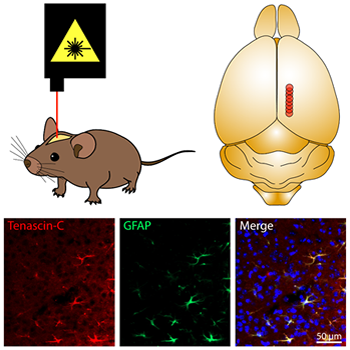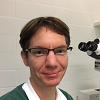The role of extracellular matrix after central nervous system lesions
Functional recovery of the human central nervous system after lesion is severely limited. In this context, the extracellular matrix plays an important role. It is secreted by the cells into the extracellular space and contains signals that regulate survival, differentiation, and migration of cells in the tissue as well as axon growth and the formation of synaptic contacts. After injury, a process called "reactive gliosis" is observed. Amonst others, astrocytes are activated and start to produce numerous molecules that regulate the cell fate of the adjacent cells. One such factor is Tenascin-C, which is also prominently expressed during development.
The project aims to unravel the role of extracellular molecules with regard to regeneration of brain lesions. The reciprocal influence of transplanted stem cells and extracellular matrix will be examined. This will improve the understanding of the molecular processes after injuries and may help to develop new strategies to promote the regenerative potential.
The following methods are applied in this project: First, focal laser lesions are induced in the mouse model (cooperation with Prof. U. T. Eysel). Afterwards, the extracellular matrix composition and the identity of the cells are analyzed by immunohistochemical stainings and fluorescence microscopy. Stem/progenitor cells are expanded in cell culture before transplantation and their influence on regeneration is elucidated by comparison with untreated control animals. In addition, PCR and Western blot are used to characterize the stem cells.
Short academic CV:
- Studies in biology at the Ruhr University Bochum
- 2009: Diploma in biology
- Since 2009: IGSN scholarship & scientific research assistant at the Ruhr University Bochum at the Department of Cell Morphology and Molecular Neurobiology
Publications:
- Faissner A, Roll L, Theocharidis U. (2016) Tenascin-C in the matrisome of neural stem and progenitor cells. Mol Cell Neurosci. 2016 Nov 9. pii: S1044-7431(16)30222-6. doi: 10.1016/j.mcn.2016.11.003. [Epub ahead of print] Review.
- Kwiatkowska M, Reinhard J, Roll L, Kraft N, Dazert S, Faissner A, Volkenstein S. Neuroscience (2016) The expression pattern and inhibitory influence of Tenascin-C on the growth of spiral ganglion neurons suggest a regulatory role as boundary formation molecule in the postnatal mouse inner ear. Neuroscience.
- Roll L, Faissner A (2014) Influence of the extracellular matrix on endogenous and transplanted stem cells after brain damage. Frontiers in cellular neuroscience 8:219.
- Roll L, Mittmann T, Eysel UT, Faissner A (2012). The laser lesion of the mouse visual cortex as a model to study neural extracellular matrix remodeling during degeneration, regeneration and plasticity of the CNS. Cell Tissue Res
Click image to enlarge




